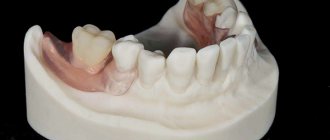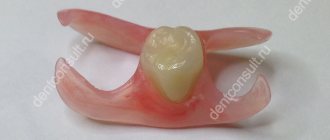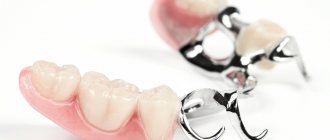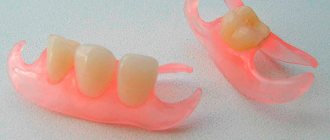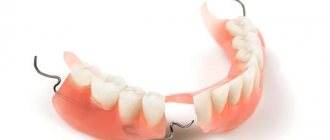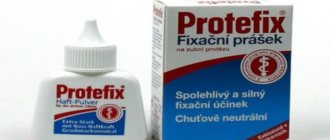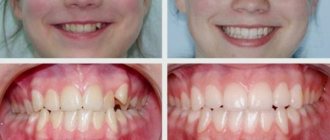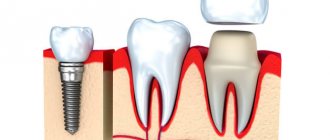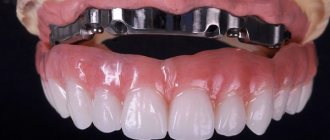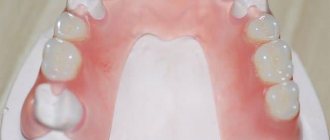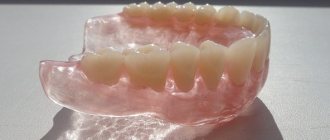Temporary dentures are used in preparation for full prosthetics. While a permanent removable or fixed prosthesis is being made, a temporary structure allows the dentition to fully function. After all, the absence of at least one or several teeth in the oral cavity leads to crowded dentition, changes in the facial skeleton and difficulties when eating and communicating. In addition, the temporary denture will hide the gaps in your teeth, and you will be able to smile and laugh widely again.
Modern temporary dentures are made of plastic and nylon. They are very light and do not injure the gums and teeth, which sometimes happens when installing permanent structures. As a rule, you have to wear a temporary prosthesis for about 2 months, and sometimes longer, until the permanent one is ready.
Are temporary dentures really necessary?
A temporary prosthesis is installed while the permanent one is being made, as well as while the implants are taking root.
It restores the aesthetics of a smile, chewing function and preserves the bite, that is, it prevents neighboring teeth from collapsing and the opposite ones from moving into the place of the removed one. The temporary system helps you get used to the fact that permanent new teeth will soon appear in your mouth. At Stom-Firms.ru we talk about partial and complete temporary dentures, as well as the timing of their wearing.
Side effects with temporary prosthetics
Despite the fact that such structures are lightweight options and are installed for a short period of time, their constant presence in the oral cavity can also cause the development of negative consequences. Among them:
- irritation of soft tissues around the prosthesis;
- inflammatory diseases of the mucous membrane in the mouth;
- allergic reaction to painkillers or material;
- structural damage;
- the appearance of a lisp;
- disruption of local blood supply.
The dentists of our clinic will help you quickly and efficiently deal with problems if temporary dentures have been installed incorrectly. For this purpose, modern diagnostic equipment and materials are available.
For the convenience of patients, the clinic is open every day from 9.00 to 21.00, but a request for a visit can be left online. We have discounts, promotions and installment plans.
Come to us for high-quality temporary prosthetics and smile comfortably!
Partial temporary denture
Temporary structures can be removable or non-removable. Their cost, material and manufacturing process for the upper and lower jaws do not differ. Let's take a closer look at each type of prosthesis.
Butterfly: partial denture, temporary, removable
The design gets its name from the wing-shaped hooks with which it clings to adjacent teeth. That is, it can only be installed at the site of the included defect, when there are teeth on both sides of the empty socket. More often, a butterfly is installed at the site of a lost incisor; less often, it is placed in the area of chewing teeth, since it does not cope well with active chewing load. It replaces 1 to 3 lost units.
The following materials are suitable for prosthesis:
- Acrylic plastic . A classic, inexpensive, fairly hard and easy-to-work material;
- Nylon . Lightweight, soft, does not rub the gums and looks natural;
- Acry-Free . A modern version of acrylic, devoid of monomer, which causes an allergic reaction. Somewhat harder than nylon, therefore it better transfers chewing pressure to the bone, slowing down its atrophy;
- Quattro Ti . Expensive innovative material with enhanced aesthetics.
Temporary removable dentures mainly perform an aesthetic function and cannot fully participate in chewing, since they are much softer than teeth. The butterfly is easy to remove for hygiene procedures and just as easy to fix back in the mouth.
Temporary crown made of plastic
For permanent prosthetics, the tooth is ground down to form a stump, and the manufacture of the prosthesis begins. The process can last up to 2 weeks and if the stump remains uncovered, it:
- Exposure to carious bacteria, saliva and food;
- When chewing, some of the food gets on the gums and causes pain;
- The gums creep onto it, which will be injured during the installation of a permanent prosthesis. This can lead to gingivitis.
To protect sensitive dentin and prevent it from becoming infected with caries, plastic crowns are placed. They are made either by the direct method, immediately in the patient’s mouth, or by the laboratory method, using an impression. In the second case, the structure fits more accurately to the stump and the gingival margin is better formed around it.
The thickness, and therefore the strength of the crown, depends on how many millimeters the tooth was ground. If the volume of worn-off enamel is large enough, the plastic is reinforced with metal mesh or fiberglass. This increases the strength of the plastic and extends its service life.
Sometimes temporary crowns are made from metal-plastic. Here, on the contrary, the cast metal crown is covered with a layer of plastic on the front side. Both types of temporary plastic crowns for chips can be restored directly in the patient’s mouth.
A temporary crown on an implant is necessary for implantation with immediate loading. More often, a plastic crown is fixed to implants in the frontal zone or during basal implantation, when the implants are screwed into the deep layers of the jaw. Thanks to this, the aesthetics of the dentition quickly returns, a beautiful, smooth edge of the gum is formed and the implant is loaded in a lighter form.
All temporary crowns are made just below the adjacent teeth, thus removing them from the bite. This reduces the load on the implant when chewing and gives it time to take root.
Temporary bridge
Sometimes a single implantation in the smile zone takes place in 2 stages: in the first stage, the mucous membrane above the implant is sutured tightly until it is completely engrafted. This will require from 3 to 6 months, and in the case of bone grafting - up to 8 months. During osseointegration, an adhesive or Maryland bridge can be placed over the gum rather than a removable butterfly prosthesis. But they can restore no more than 2 teeth.
Using an impression, the dentist makes a prosthesis from plastic with side plates in the form of legs. Recesses are drilled on the adjacent teeth where these paws are glued. Another option is to fix fiberglass tape in the recesses, on which the dentist forms an artificial tooth right in the mouth. Both options are not strong enough, so the Maryland bridge cannot be chewed or bitten.
Due to its fragility, an adhesive bridge is not suitable for canines and molars. Therefore, a temporary bridge is placed on the chewing teeth, either a plastic one, or crowns are placed only on the ground abutment teeth.
Stages of making temporary dentures
The first step to installing temporary restorations is to have your mouth examined by your dentist. This is done in order to assess the condition and find out whether prosthetics are possible in this case. The following steps are followed:
- An impression is made from untreated crowns.
- The adjacent teeth are sharpened.
- The prosthesis is made and installed in place.
Butterfly prosthesis for the upper front tooth
The material for fixation is special hypoallergenic cement. The entire manufacturing process takes approximately 1-2 days. Dentures are installed for a period of 1-6 months, depending on how long it takes to make and fit permanent dentures. Our specialists have gained extensive experience, so orthopedic devices are made with high precision and a large margin of safety.
Complete temporary prosthesis
An adaptation prosthesis for a toothless jaw is necessary for prosthetics on implants. According to the All-on-4, All-on-6 and dental implantation methods, artificial teeth are permanently fixed within 72 hours after surgery.
In order for implants to take root well, they need a load, but it must be reduced. Therefore, the temporary structure is made of metal-plastic or acrylic. Recently, diamond nanoparticles have been added to the acrylic mass to make artificial teeth and gums look natural.
When are temporary implants placed?
- There is an urgent need to restore aesthetics and chewing function;
- with ectodermal hypohidrotic dysplasia, which provokes underdevelopment of teeth;
- orthodontic treatment of dental pathologies;
- to protect soft tissues at the site of installation of a permanent implant during classical implantation.
Temporary dental implants solve the following problems :
- relieve the patient from psychological discomfort;
- after grinding the tooth under the prosthesis, its unattractive appearance is hidden;
- exclude infection and the development of inflammation inside the ground tooth;
- eliminate hyperesthesia after turning;
- take on the chewing load, promoting the consumption of familiar foods;
- accelerate gum healing;
- protect against deformation and bone atrophy;
- promote uniform load distribution;
- allow to reduce the time of prosthetics.
The need to install temporary implants is dictated by the implantation method and the area of the jaw in which the lost tooth is restored. For example, when replacing a chewing tooth with prosthetics, a mini-screw may not be needed.
Sometimes, after successful engraftment of permanent implants (after 3-6 months), temporary mini-screws also grow in. In this case, they are left and filed down - they can be used as an additional support for the denture.
How long to wear temporary dentures
Temporary dentures are designed to last for a certain period of time, but many people try to wear them longer. The table below contains recommended and possible periods of wearing, as well as the consequences and complications of long-term wearing of structures:
| Type of prosthesis | Optimal service life | Deadline for use | Why you shouldn't wear temporary dentures for too long |
| Plastic crown | 1 month | 3-4 months | Plastic quickly wears down, chips, darkens and absorbs odors. It does not fit very well to the stump, allows bacteria to pass under it and causes tooth decay. Negatively affects the mucous membrane |
| Reinforced | A few months | 1.5 years | |
| Metal-plastic | A few months | 5 years | |
| Butterfly | Up to 1 year | 5 years | Over time it fades, smells bad and becomes rough. The bone underneath continues to atrophy |
| On implants | For the period of osseointegration, from 3 months to a year | 3 years | Contaminated plastic negatively affects the mucous membrane, and insufficient load affects the quality of fixation of implants in the bone. Peri-implantitis may begin. |
Adaptive prostheses are intended for temporary use. If you use them longer, various diseases inevitably begin to develop in the oral cavity.
The process of addiction
Getting used to wearing temporary dentures depends on the individual’s capabilities.
For some people, this takes a few hours. However, there are also situations when the patient absolutely cannot come to terms with the presence of a foreign element in his mouth.
There should be no pain after temporary prosthetics.
Sometimes patients are concerned about changes in the amount of saliva secreted (increase or decrease). Typically, such a violation indicates poor-quality prosthetics.
To speed up the adaptation to the use of a prosthesis, doctors usually recommend using a special (intraoral) massage.
It is done like this: the index finger clamps the artificial tooth, and the thumb performs massaging movements of the gums (up and down movements, pressing, spiral movement).
How to care
Temporary restorations require the same high-quality hygienic care as regular teeth.
With poor care, the accumulation of food debris and the occurrence of unpleasant processes in the gums (swelling, pain) cannot be avoided.
Problem areas with temporary plates are the junction with the teeth and its lower part. You can combat plaque buildup in these areas by using a medium-hard toothbrush at a 45-degree angle. It is also necessary to rinse your mouth after a meal and use herbal decoctions or infusions (sage, calendula, chamomile).
You can use ready-made pharmacy rinses that contain medicinal substances and prevent gum inflammation (Forest Balsam, Lakalut, Listerine, President, etc.)
If a temporary denture is removed, it must be periodically placed in a special solution.
The solution is changed after each use. Also, special tablets for dentures are used for this (Korega, Protefix, Dentipur, etc.)
When wearing non-permanent plates, the following recommendations should be followed:
- Avoid eating sticky or very hard foods;
- minimize the chewing load on the area with the plate;
- use dental floss carefully: do not pull it out sharply, but pull it smoothly downwards away from the face.
The prosthesis fell out: what to do?
- It is not recommended to wear temporary crowns for a long time.
- If the prosthesis suddenly falls off, you need to visit a doctor and have the structure reinstalled.
- At night, it is better to remove removable dentures and keep them in a glass of water.
Whether or not to get temporary dentures is up to you to decide. Most often, patients are held back from making a positive decision by only one thing: the need for additional expenses.
Sources used:
- “Partial removable dentures” (Zhulev E.N.)
- Chalifoux, Paul R. (2015). "Acrylic and other resins: Provisional restorations". Acrylic and other resins: Provisional restorations – Esthetic Dentistry (Third Edition)
- "Dental art: A French dentist showing his artificial teeth." British Dental Association.
